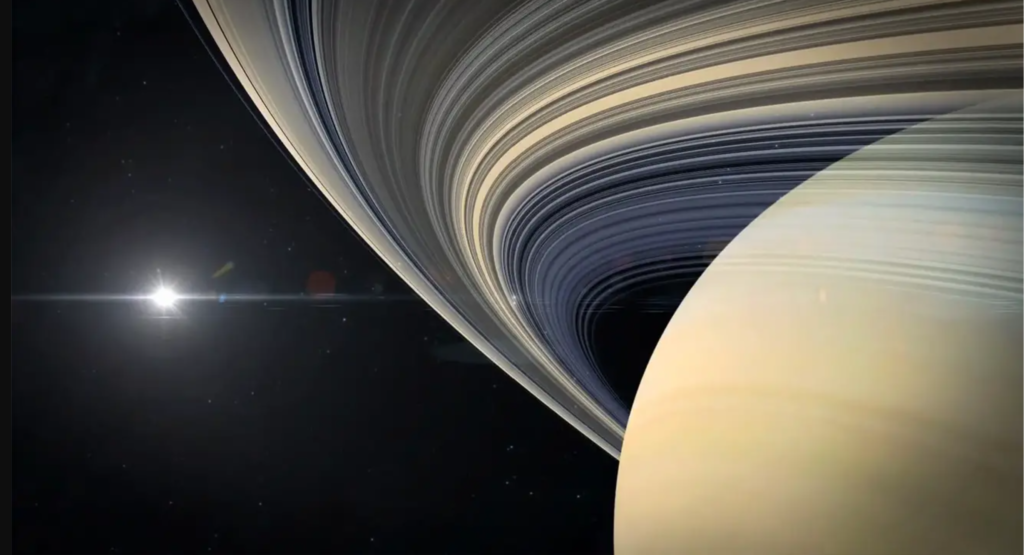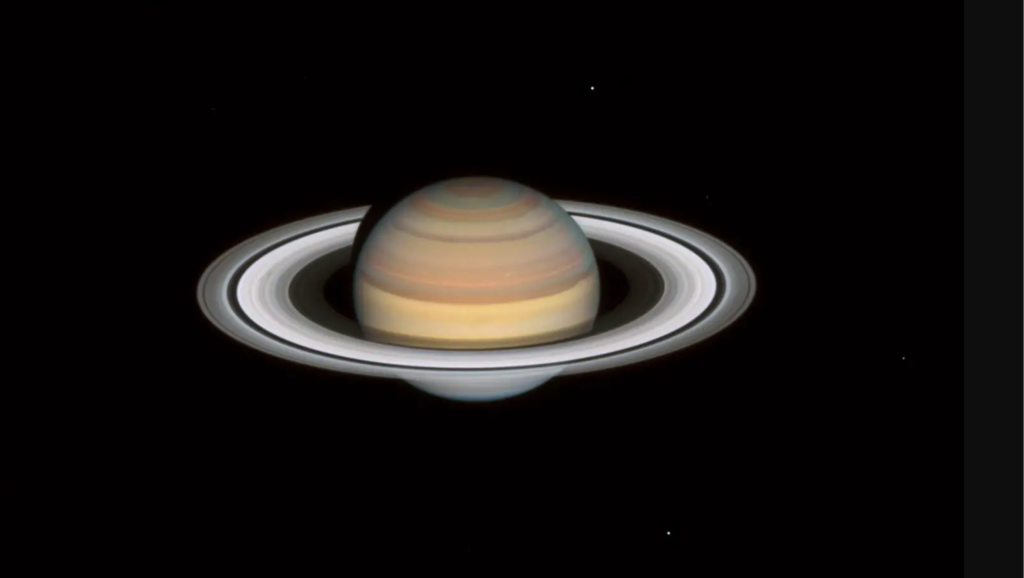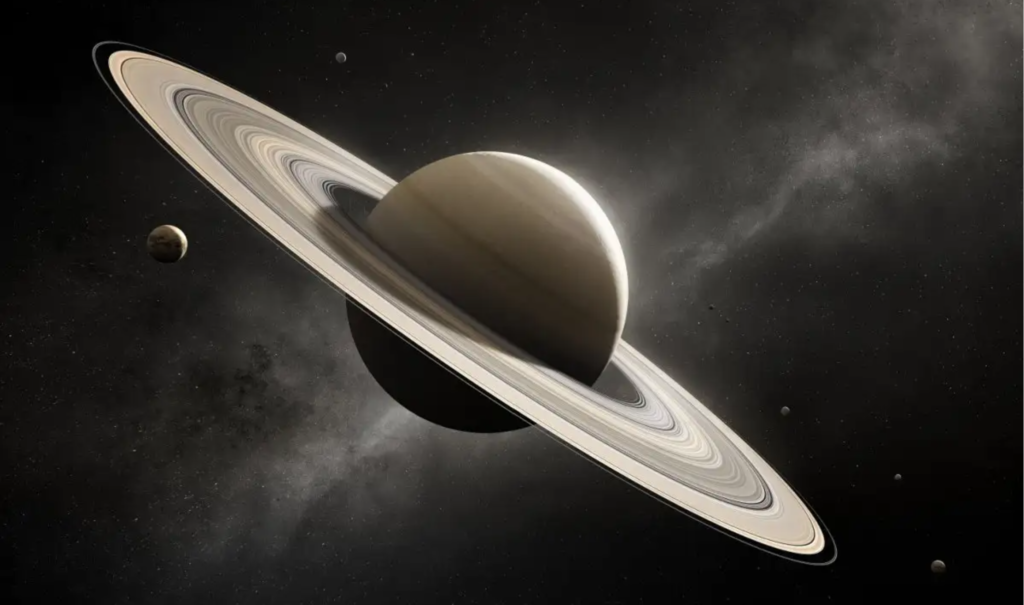The solar system is full of wonders and mysteries, and one of them is the phenomenon of planetary rings. Planetary rings are thin, flat, and circular bands of dust, ice, and rock that orbit around some of the planets in our solar system. The most famous and spectacular example of planetary rings is Saturn, which has a complex and beautiful ring system that can be seen even with a small telescope. However, Saturn is not the only planet with rings. In fact, all of the outer gas giant planets — Jupiter, Saturn, Neptune, and Uranus — have rings around them, although they are much less visible and varied than Saturn’s. But what are these rings made of, how did they form, and what are their effects on the planets and their moons?
What Are Planetary Rings Made Of?
Planetary rings are made up of countless particles that range in size from tiny dust grains to large boulders. These particles are mostly composed of water ice, but they can also contain other materials, such as rock, carbon, sulfur, and organic molecules. The composition and color of the rings depend on the origin and history of the particles, as well as the interactions with the planet, the sun, and the moons.

Illustration of Saturn and its rings. All of the outer gas giant planets — Jupiter, Saturn, Neptune, and Uranus — have rings around them.
Also read : Celestial Alignment: Exploring The Rare Phenomenon Of Planetary Conjunctions In Our Solar System
The particles in the rings are held together by the gravitational attraction of the planet, but they are also influenced by other forces, such as the tidal forces of the sun and the moons, the magnetic fields of the planet, and the collisions and impacts among the particles. These forces shape the structure and dynamics of the rings, creating gaps, waves, arcs, and spokes in the rings.
The rings are also divided into different regions, depending on their distance from the planet. The innermost region is called the main ring, which is the thickest and brightest part of the ring system. The main ring is usually composed of several sub-rings, each with its own name and characteristics. For example, Saturn’s main ring consists of the A, B, and C rings, which are separated by gaps called the Cassini and Encke divisions2. The outermost region is called the dust ring, which is the thinnest and faintest part of the ring system. The dust ring is composed of very small and fine particles that are easily blown away by the solar wind or the radiation pressure of the sun. For example, Jupiter’s dust ring consists of the main, halo, and gossamer rings, which are very difficult to detect and observe.
How Did Planetary Rings Form?

The origin and evolution of planetary rings are still not fully understood, and there are different theories and hypotheses that attempt to explain them. One of the most widely accepted theories is that the rings formed from the debris of objects that were destroyed by the gravitational forces of the planet. These objects could be comets, asteroids, or moons that came too close to the planet and were torn apart by its tidal forces, or that collided with each other and shattered into pieces. The debris then spread out into a thin disk around the planet, forming the ring system.
Another theory is that the rings formed at the same time as the planet, from the leftover material of the protoplanetary disk, which was a cloud of gas and dust that surrounded the young sun and gave birth to the planets. Some of the material that did not accrete into the planet remained in orbit around it, forming the ring system.

A third theory is that the rings formed from the material that was ejected from the planet or its moons, due to volcanic eruptions, geysers, or impacts. The material then escaped into orbit around the planet, forming the ring system.
These theories are not mutually exclusive, and it is possible that the rings formed from a combination of these processes, or that they changed over time due to different events and factors. The rings are not static or permanent, but rather dynamic and ephemeral, and they may disappear or reappear in the future.
What Are the Effects of Planetary Rings?
Planetary rings have significant effects on the planets and their moons, as well as on the exploration and understanding of the solar system. Some of the effects of planetary rings are:

- The rings reflect and scatter the sunlight, affecting the temperature and climate of the planet and its moons. For example, Saturn’s rings block some of the sunlight from reaching the planet, making it colder than it would be without the rings.
- The rings interact with the magnetic fields of the planet, creating electric currents and plasma waves that can affect the radio signals and the auroras of the planet and its moons. For example, Saturn’s rings generate a radio emission that can be detected by radio telescopes and spacecraft.
- The rings influence the orbits and shapes of the moons, due to the gravitational and tidal forces between them. The rings can also exchange material with the moons, creating or modifying their surfaces and atmospheres. For example, Saturn’s rings are maintained by the gravitational interactions with some of its moons, such as Mimas, Enceladus, and Titan, which create gaps and resonances in the rings. The rings also feed material to some of its moons, such as Rhea and Iapetus, which have dusty and icy coatings on their surfaces.
- The rings provide opportunities and challenges for the exploration and observation of the planet and its moons, by offering unique and spectacular views and insights, but also posing risks and difficulties for the navigation and communication of the spacecraft. For example, Saturn’s rings have been explored and studied by several missions, such as Pioneer 11, Voyager 1 and 2, and Cassini-Huygens, which have revealed the structure, composition, and dynamics of the rings, as well as the presence of new moons and phenomena within the rings.

Planetary rings are one of the most fascinating and mysterious features of the solar system, and they have captivated the imagination and curiosity of scientists and enthusiasts for centuries. Planetary rings are thin, flat, and circular bands of dust, ice, and rock that orbit around some of the planets in our solar system, especially the outer gas giant planets. Planetary rings are made up of countless particles that vary in size and composition, and that are shaped by various forces and factors. Planetary rings have different origins and histories, and they may change over time due to different events and processes. Planetary rings have significant effects on the planets and their moons, as well as on the exploration and understanding of the solar system. Planetary rings are a wonder and a mystery that we continue to explore and unravel.
Also read : The Galaxy’s Magnetic Field Has Been Detected 11 Billion Light-Years Away, Making It The Farthest Ever




































